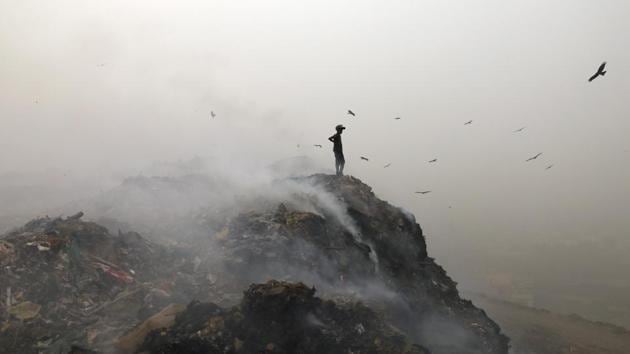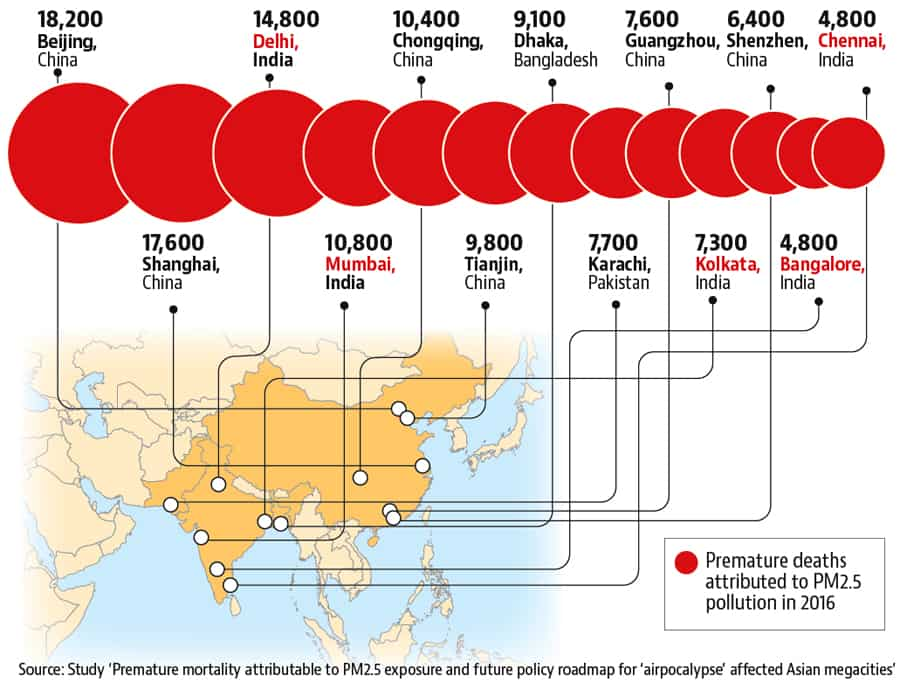Delhi pollution: Fine dust killed 15,000 prematurely in 2016, says study
Apart from the deaths in Delhi, the study also showed that Mumbai, which was one of five megacities considered from India, reported the fourth highest number of deaths among 12 megacities.
Close to 15,000 people died prematurely in Delhi in 2016 from illnesses linked to fine particulate matter pollution, according to a new study by researchers from India, Singapore and Thailand that assessed pollution-related deaths in 13 megacities in south Asia and China.

Heart disease, stroke, lung diseases, lung cancer among adults and upper respiratory tract illnesses in children are all related to particulate pollution exposure.
The study, accepted for publication in Elsevier’s Process Safety and Environmental Protection journal, found that most deaths related to PM 2.5 (particulate matter 2.5 microns or less in diameter), were reported from Beijing (18,200), Shanghai (17,600) and Delhi.
“Chinese cities report higher mortality numbers, despite lower pollution levels than cities like Delhi because the population in their cities is more,” Kamal Jyoti Maji, a co-author of the paper, explained. “Also there is a higher burden of elderly people who are disproportionately affected by air pollution exposure.”
Beijing’s population is close to 22 mn compared to 18 mn in Delhi (the latter is as per the 2011 census).
Mumbai, which was one of five megacities considered from India, reported the fourth highest number of deaths. This is the first time the disease burden associated with PM 2.5 has been calculated for Chennai and Bangalore, according to the authors.

In both Chennai and Bengaluru, almost 5,000 people died from PM 2.5 linked causes in 2016. Various reports have highlighted that air pollution is a problem across the country, and a growing monitoring network has only uncovered the extent of the problem.
A Global Burden of Disease report published last year estimated that 1.1 million deaths in India were linked to PM 2.5 air pollution in 2015. Air pollution- linked deaths in India could increase to 3.6 million by 2050 if no further actions are taken, according to a report published by the Health Effects Institute and Indian Institute of Technology- Bombay this year.
A severe air pollution episode in Delhi last November sparked concern with multiple agencies from the National Green Tribunal to the Prime Minister’s office to most recently the NITI Aayog releasing their own plans to tackle the issue. Despite this, no clear roadmap to tackle the problem has emerged, activists said.
“The current policy is not enough to protect public health in any megacity in India, Pakistan and Bangladesh. The future also looks bleak if current policies continue,” Maji said, adding that “China has stronger regulatory mechanisms and time-bound specific targets.”
The Union environment ministry released a draft of the National Clean Air Programme. The draft was strongly criticized for the absence of specific targets for pollution reduction and the absence of adequate attention to the health impacts of air pollution.
“We have held consultations with the states., the programme will be finalised this month,” a senior official who did not wish to be named, said. The official said that different states would have different capacities to reduce pollution levels so umbrella targets may not work.
“It’s good that the environment ministry is finally thinking of implementing the much anticipated National Clean Air Programme. NCAP should be the ultimate framework to ensure compliance to our commitment towards tackling air pollution from all the sources,” Sunil Dahiya, an air pollution campaigner with Greenpeace India, said. “Without time-bound emission and sectoral targets, the National Clean Air Programme will be ineffectual.”
Get Current Updates on India News, Lok Sabha Election 2024 live, Infosys Q4 Results Live, Elections 2024, Election 2024 Date along with Latest News and Top Headlines from India and around the world.




